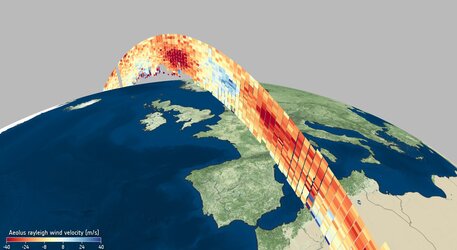Earth Observation at Ministerial Council
The ESA Council at Ministerial level, CM22, is a time for critical decisions. In November 2022, ESA’s Member States, Associate States and Cooperating States will come together to strengthen Europe’s space sector and ensure it continues to serve European citizens.
Earth-observing missions are essential for taking appropriate action to secure a sustainable future. Satellite data not only allows us to grasp the magnitude of environmental change, but it also brings a myriad of benefits to society and the economy – leading to a better life for all.
ESA’s Earth observation proposals for CM22 will build on the successes of its Earth Observation Programmes, ensuring its continuity, but will take measuring and monitoring to a whole new level. Building on four decades of satellite data, ESA will work to move from enabling climate research to empowering climate action.
Main Goals
- Use satellite data to achieve the European Green Deal and Digital Agenda
- Deliver space solutions to geopolitical risks, including the climate, energy and food crises
- Increase and expand collaboration with international partners and commercial players
- Maintain Europe’s lead in Earth science and technology
Leading with purpose
ESA’s Earth observation proposals for CM22 will safeguard and further strengthen Europe’s position in its role of global climate guardian and champion within a growing green economy. Earth observation will keep Europe in front by developing new applications and creating business opportunities in a fast-evolving geo-services sector, all in line with the digital and commercialisation revolution.
Taking responsibility
Meeting the commitments and targets of the Paris Agreement, European Green Deal and the UN Sustainable Development Goals would be impossible without the insights of Earth observation. Beyond keeping promises, it is also about saving lives. Earth observation allows us to better deal with the increase in natural disasters by providing risk assessment, warning signals, emergency response management and post-impact damage assessment.
ESA is proposing a timely and coherent European package in line with the ambitious, long-term objective of achieving carbon neutrality by 2050, in Europe and beyond:
FutureEO: Preparing for tomorrow
Through FutureEO – ESA’s core Earth observation research and development programme – ESA is committed to maintaining its responsibility for Europe’s strategic autonomy in Earth science and spaceborne technology.
FutureEO not only harnesses new ideas to develop pioneering satellite missions and concepts, but it also fosters innovative ways of using Earth observation data that enables scientific excellence to flourish. The programme underpins the development of operational satellite missions dedicated to delivering data to address environmental challenges of tomorrow – as well as improving daily lives and boosting the economy.
Enhanced continuity
We need to continue, and enhance, the Copernicus Space Component to meet new and growing user needs, as well as support decision-makers.
Improved weather predications
Building on the success of Aeolus, Aeolus-2 will improve the accuracy of numerical weather prediction and benefit precision farming, food security as well as search and rescue operations.

Industrial innovation with InCubed-2
Embracing commercialisation, ESA’s co-funding programme, InCubed, helps to develop commercial products that exploit the value of Earth observation. To further support the commericalisation revolution, ESA offers its technical expertise to facilitate access to private capital in new cooperative schemes.
Strengthen climate monitoring and reporting
Continuing the successful work of the Climate Change Initiative, Climate-Space will support climate action on a national (emission reporting and mitigation), regional (European Green Deal) and global scale (UNFCC Paris Agreement).
Continue mission development: TRUTHS
TRUTHS will set the ‘gold standard’ reference for climate measurements. It will ensure the crosscalibration and reliability of data from various climate missions that underpin critical models.
Boost Earth observation data with Digital Twins
State-of-the-art digital technologies such as Digital Twins can manage exponentially growing space data sets. This will allow institutions, the scientific community, citizens and industry to harness space data for their use.
Preserve long-term data with the Heritage Space Programme
To make the most out of the long-term data sets when tackling the climate crisis, we must preserve and improve them to ensure quality and comparability with newer missions.
Expand Earthnet
Earthnet is a reliable, strategic network of third-party missions that complement ESA ones. Earthnet’s continuity enables data access to scientific users and will encourage commercialisation by involving NewSpace companies as data providers or data users.


Access the video
Back to homepage |














 Germany
Germany
 Austria
Austria
 Belgium
Belgium
 Denmark
Denmark
 Spain
Spain
 Estonia
Estonia
 Finland
Finland
 France
France
 Greece
Greece
 Hungary
Hungary
 Ireland
Ireland
 Italy
Italy
 Luxembourg
Luxembourg
 Norway
Norway
 The Netherlands
The Netherlands
 Poland
Poland
 Portugal
Portugal
 Czechia
Czechia
 Romania
Romania
 United Kingdom
United Kingdom
 Slovenia
Slovenia
 Sweden
Sweden
 Switzerland
Switzerland


































